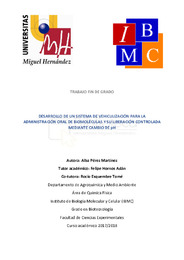Por favor, use este identificador para citar o enlazar este ítem:
https://hdl.handle.net/11000/6349Registro completo de metadatos
| Campo DC | Valor | Lengua/Idioma |
|---|---|---|
| dc.contributor.advisor | Hornos Adán, Felipe | - |
| dc.contributor.advisor | Esquembre Tomé, Rocío | - |
| dc.contributor.author | Pérez Martínez, Alba | - |
| dc.contributor.other | Departamentos de la UMH::Agroquímica y Medio Ambiente | es |
| dc.date.accessioned | 2020-09-15T08:11:58Z | - |
| dc.date.available | 2020-09-15T08:11:58Z | - |
| dc.date.created | 2018-03-06 | - |
| dc.date.issued | 2020-09-15 | - |
| dc.identifier.uri | http://hdl.handle.net/11000/6349 | - |
| dc.description.abstract | En la actualidad, el uso de nanopartículas en investigación está creciendo, debido a su gran aplicabilidad en biotecnología, concretamente en la biomedicina, desde el tratamiento del cáncer focalizado, hasta su uso como sistemas vehiculizadores de fármacos. Respecto a este punto, la vehiculización eficaz de fármacos en el tracto digestivo se hace necesaria cuando hablamos de las distintas barreras que opone el estómago a las sustancias exógenas. Debido a esto, fármacos como la insulina todavía no pueden ser administradas oralmente en pacientes diabéticos. En este trabajo, se han usado nanopartículas de alúmina (Al2O3) recubiertas por un polielectrolito aniónico, poli-vinil-sulfonato (PVSA), para desarrollar un método que nos permita vehiculizar la insulina hasta el interior del tracto digestivo, donde debe ser capaz de superar barreras tales como el ataque de las proteasas o el pH ácido presente en el estómago. Tras caracterizar las nanopartículas recubiertas usando una proteína modelo como la lisozima mediante su adsorción y posterior desorción de la superficie en diferentes condiciones, se usó la proteína β- lactoglobulina por presentar un punto isoeléctrico similar a la insulina. De esta forma, se supone que la liberación va a ser posible debido a las diferencias de pH del estómago y del tracto digestivo (1,5 frente a 7). Los resultados muestran que tras adsorber 0,5 mg/ml de β-lactoglobilina a pH 1,5, somos capaces de recuperar un 74 % de la proteína como consecuencia del aumento de pH hasta valores fisiológicos (pH 7). | es |
| dc.description.abstract | In the last few years, there is an unprecedented increase in the use of nanoparticles in biotechnology, especially in biomedicine, being the treatment of localized cancer or their use as drug carrier only two examples. In this respect, the effective transport of drugs in the digestive tract becomes necessary in order to overcome the barriers that the stomach opposes to exogenous substances. Because of this, drugs such as insulin cannot yet be administered orally to diabetic patients. In this work, alumina nanoparticles (Al2O3) coated by an anionic polyelectrolyte (polyvinylsulfonate, PVSA) have been obtained with the objective of developing a new method for the transport of insulin to the interior of the digestive tract. The long-term goal of the research presented here is to avoid the hormone degradation due to the harsh conditions found in the stomach (both low pH and the presence of proteases). Both the adsorption and pH-induced desorption of the model protein lysozyme have been studies under different pH and ionic strength conditions. Finally, these studies have been extended to β-lactoglobulin due to its similar isoelectric point, pI. At the stomach pH, insulin, being below its pI is positively charged and therefore readily adsorb to the NPs. At pH 1,5 and in the absence of salt, 0,5 mg of β-lactoglobilin become adsorbed to 1 mg of PVSA-coated Al2O3 NPs. When pH is changed from pH 1,5 to pH 7 (similar to the pH of the intestine), the protein becomes charged negatively and its desorption is induced due to repulsive electrostatic interactions with the coated NP. Our results show that after adsorbing 0,5 mg of β- lactoglobulin per mg of NP at pH 1,5, the pH-jump to pH 7 resulted in the desorption of 74% of the protein. | es |
| dc.format | application/pdf | es |
| dc.format.extent | 40 | es |
| dc.language.iso | spa | es |
| dc.rights | info:eu-repo/semantics/openAccess | es |
| dc.subject | Nanopartículas de Al2O3 | es |
| dc.subject | polielectrolito | es |
| dc.subject | β-lactoglobulina | es |
| dc.subject | PVSA | es |
| dc.subject | PDADMACl | es |
| dc.subject.other | CDU::5 - Ciencias puras y naturales::54 - Química::544 - Química física | es |
| dc.title | Desarrollo de un sistema de vehiculización para la administración oral de biomoléculas y su liberación controlada mediante cambio de ph | es |
| dc.type | info:eu-repo/semantics/bachelorThesis | es |
| dc.contributor.institute | Instituto de Biología Molecular y Celular | es |

Ver/Abrir:
TFG Pérez Martínez Alba.pdf
2,15 MB
Adobe PDF
Compartir:
 La licencia se describe como: Atribución-NonComercial-NoDerivada 4.0 Internacional.
La licencia se describe como: Atribución-NonComercial-NoDerivada 4.0 Internacional.
.png)